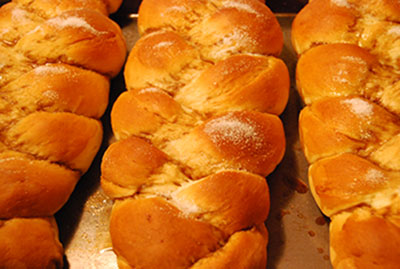 The concept of tradition always brings to my mind the image of Tevye in Fiddler on the Roof. Shaking his elbows and dancing down the dirt track to his farm, he joyfully proclaims the traditions upon which he built his life. “Because of our traditions,” he declares, “every one of us knows who he is.” Tradition for Tevye is a solid and unquestionable foundation for life.
The concept of tradition always brings to my mind the image of Tevye in Fiddler on the Roof. Shaking his elbows and dancing down the dirt track to his farm, he joyfully proclaims the traditions upon which he built his life. “Because of our traditions,” he declares, “every one of us knows who he is.” Tradition for Tevye is a solid and unquestionable foundation for life.
This time of year is steeped in tradition. Like Tevye, I find satisfaction in the continuity of custom. In a sometimes unpredictable life, it is comforting to be able to anticipate how a scene will unfold with every participant knowing his role. I look forward to gatherings of family and friends, which, for me, make all of the seasonable bustle worth it. “Traditions are the thread that unite and comfort us,” Laura Munts says in a Huffington Post blog. They transcend “time and generations.”
As I move through life, I find tradition is not the solid, unvarying force it once seemed. Through marriage and re-marriage, traditions, by necessity, have to bend and yield. When a couple marries, it is not just the lives of two people that merge. It is often the lives of two groups of people with different sets of expectations and practices. “New situations demand that new traditions be established” agrees Dianne Harman in another Huffington Post blog. With new in-laws and perhaps step-children, “trying to please all of them can become a nightmare.” Old traditions are modified or discarded. New ones emerge.
My husband’s family is of Finnish origin. One unbroken Christmas tradition in his family is baking pulla. Pulla is a sweet bread, flavoured with cardamom, glazed with coffee, and baked in golden braids. His mother taught him to make it and he does so every year. To him, pulla is the most Christmas of things?a cherished recipe to lovingly bake and share with family.
This year he is teaching his 15-year-old granddaughter, Veronica, to make pulla. The kitchen is full of the scents of yeast and spice. Two sets of hands, one young and one old, measure and knead and braid. As I listen to their hushed, conspiratorial voices I realize this is not just the passing on of knowledge and recipes. It is a sacred impartation of love and the creation of a lasting memory. Decades from now Veronica will pass along the recipe, together with its family love, in an unbroken intergenerational chain.
This tradition of pulla, so simple, will carry on. Other cherished traditions may fall away. Divorce and death sometimes bring an abrupt halt to family traditions. One friend, facing her first Christmas without her mother, mourns more than the loss of a parent. Her mother was the pillar of the family and the keeper of tradition. Now her grown up children feel adrift. In such situations, “the loss of seasonal traditions results in secondary losses and grief” cautions Munts. Will my friend and her siblings drift from tradition or will they rally around it and draw comfort and memories from it?
In the movie, Tevye rails against the loss of tradition. His daughters move into their own lives with their own conventions. Tevye, believing tradition to be inflexible, thinks his daughters are rejecting him. At the end, faced with an even greater loss, he realizes that the thread of tradition may hold the fabric of life together, but it is the fabric that matters most. So I’ll weave my traditions with care, and I’ll tie the knots gently and with love.
Barbara Lehtiniemi is a writer, photographer, and AU student. She lives on a windswept rural road in Eastern Ontario.


